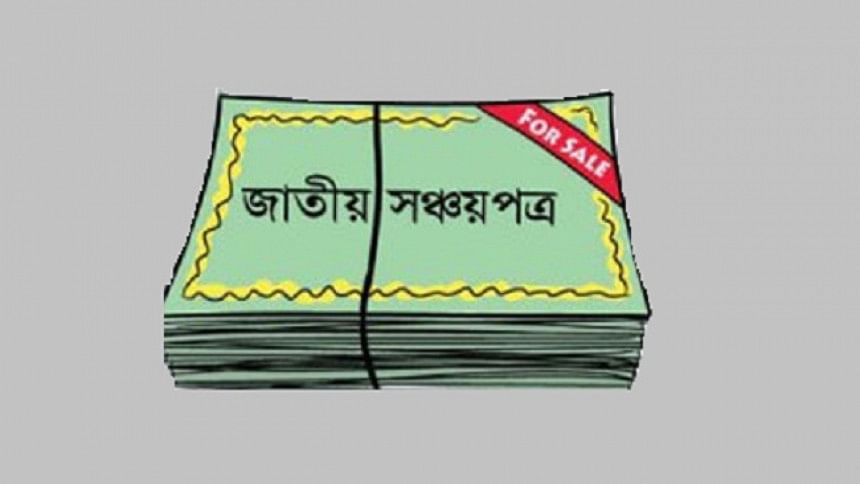Sanchayapatra and cost of borrowing

There is a lot of controversy these days surrounding the interest rates offered by Sanchayapatra of the Department of National Savings, which the government uses to finance its budget deficit. Certain quarters argue that the government is incurring excessive cost compared to alternate modes of financing like bank borrowing. Banks argue that with their deposit growth shrinking, as households prefer Sanchayapatra, interest rates are likely to shoot up which will eventually increase cost of borrowing or lending rates for private sector firms. To be sure, if either or both of these claims are true, it will be a serious burden for an economy which needs to deploy its financial resources in growth-enhancing projects.
This piece assesses these claims objectively and makes two central conclusions. First, cost of borrowing/lending rate for private firms will rise even more if Sanchayapatra is removed, compared to a case where sale of Sanchayapatra is continued. Second, the additional expense the government incurs by issuing Sanchayapatra is significantly overstated compared to bank borrowing.
To illustrate that private firms will face higher borrowing cost if Sanchayapatra is removed, we consider a simplified example below which has one central assumption—that money which would otherwise have gone to Sanchayapatra, will now be "diversified" across various assets and will not entirely flow into banks, while the government will borrow much more from banks.
We will look at two cases: A and B. The idea of these cases is to see which case leaves banks with more/less money after all economic activity takes place, which will tell us in which case interest rates will be higher.
Impact on private sector borrowing cost
In Case A, the government plans to finance a budget deficit of Tk 100 evenly through Sanchayapatra (Tk 50) and bank borrowing (Tk 50). Assume banks had Tk 50 from previous years when deposit rates were similar to those of Sanchayapatra, unlike today.
Assume also that households have this Tk 100 (which they earned by working in private sector firms) that the government needs. Households are willing to lend to the government by investing in the financial asset that generates the highest risk-adjusted return. Today, with Sanchayapatra rates much higher, households will lend the entire Tk 100 to the government through Sanchayapatra. Since Sanchayapatra yields high return without any risk, households are unlikely to invest in the stock market.
So in this case, the government finances the whole Tk 100 deficit through Sanchayapatra, leaving banks "stranded" with the Tk 50 it had hoped to lend to the government.
But luckily, there are private sector borrowers who want, let's say, Tk 30 from banks. So banks are now left with only Tk 20 (50 minus 30). By and large, this case is a simplification of what's really happening these days.
Next, consider Case B where government completely removes Sanchayapatra and plans on borrowing from banks only. As before, assume banks have initial deposit of Tk 50, while the government needs Tk 100. Without Sanchayapatra, it plans to borrow the entire amount of Tk 100 from banks.
With Sanchayapatra removed, households will now also want to spread out its investment over various assets since bank deposit rates are much lower: perhaps a combination of bank deposits, stocks, bonds, domestic real sector asset and overseas asset. In a country where the general public sorely lacks confidence in the stock market, it's highly unlikely that households will park majority of their hard-earned income in risky equities where liquidity of fundamentally strong stocks is low.
So let's say, households invest Tk 20 in some combination of stocks/bonds/domestic real sector/overseas assets and deposit the remaining Tk 80 in banks. Notice that they did not put their entire Tk 100 in banks.
So this means banks will now have Tk 130 (50 initially plus new inflow of Tk 80 from households).
Since the government now finances the entire Tk 100 deficit from banks, the latter is left with Tk 30 (130 minus 100). But remember there are private sector borrowers who want that Tk 30 similar to Case A.
Observe that banks end up with less money in Case B (Tk 0 to be specific) compared to Case A (Tk 20). In other words, compared to Case A, banks in Case B have less liquidity when private firms go to them for loans. By extension, private firms will face higher lending rates in this case.
The magnitude of the numbers used does not matter. For example, suppose private borrowers wanted Tk 60, instead of 30. Then in Case A, there will be Tk 10 "crowding out" (60 minus 50) and in Case B, there will be Tk 30 crowding out of private investment (60 minus 30). In either case, we can generalise that banks have less liquidity in Case B implying higher borrowing cost for private firms.
Impact on government borrowing cost
Moving on, let's consider the cost of borrowing for the government. Most analysis we see in the media on the government's cost of borrowing through Sanchayapatra flags around 5.0-6.5 percent additional (and redundant) expense since treasury rates are currently around 4.5-6 percent (those maturing in 1 to 5 years) while Sanchayapatra yields around 11 percent. This argument rests on the fallacy that if government switches to treasury bonds (bank borrowing) to finance its deficit, treasury yields will remain unchanged.
These days since the government has called off treasury auctions with Sanchayapatra generating the money that it needs, demand for treasury bills and bonds is much higher relative to their supply. Anyone who took Finance 101 should see that high demand for treasuries means their yields are suppressed these days.
But recall that in Case B, the government is financing its deficit by borrowing entirely through banks. So it has to increase the supply of treasuries relative to its demand, leading to a fall in bond prices. Clearly then, bond yield has to go up.
Though without proper econometric analysis we cannot forecast exactly by how much, a safe assumption would be that yields of five-year bonds (in which most banks like to park funds) will rise to around 9-10 percent from its current level of six percent. This view can be corroborated by looking at Bangladesh Bank data on bond yields from 2012 and 2013, when excess liquidity in banks was lower and deposit rates were much higher.
The upshot is that additional cost the government incurs by issuing Sanchayapatra is a lot lower than what we might have thought—around two percent or even less.
Other issues
Some analysts will remind us that if Sanchayapatra is removed, the government can simply increase its reliance on foreign aid instead of putting too much pressure on banks. While this is true, a huge shift in composition towards external sources is unlikely in the near future. Remember that disbursement of concessional loans generally takes a lot of time, which might not be feasible for government's spending purposes at least operationally. And sometimes the conditionalities demanded by international organisations come with their own costs and roadblocks (political factors for one thing). Money from Sanchayapatra or treasury bonds is generated almost "instantly" since buyers are readily available.
Also, once Bangladesh graduates from LDC status, we will need to issue sovereign bonds to access international money, which obviously will be priced at market rates. Given that domestic five-year bond yield is around six percent right now, it's unlikely that sovereign bonds, which include currency risk, will be any less than eight percent if not more. Some will argue it could be higher.
Finally, note that we do not consider changing other macroeconomic variables like central bank policy rate, since that will prevent us from isolating the effect of removing Sanchayapatra on borrowing cost.
To be sure, the market mechanisms outlined in the preceding analysis take some time. But once the dust settles, the effects outlined will turn out to be what economists term an equilibrium. The idea that Sanchayapatra is costing us a "fortune" is more of a myth than a reality.
Sharjil Haque is a doctoral student in economics at the University of North Carolina, and former research analyst at the International Monetary Fund in Washington, DC.





Comments